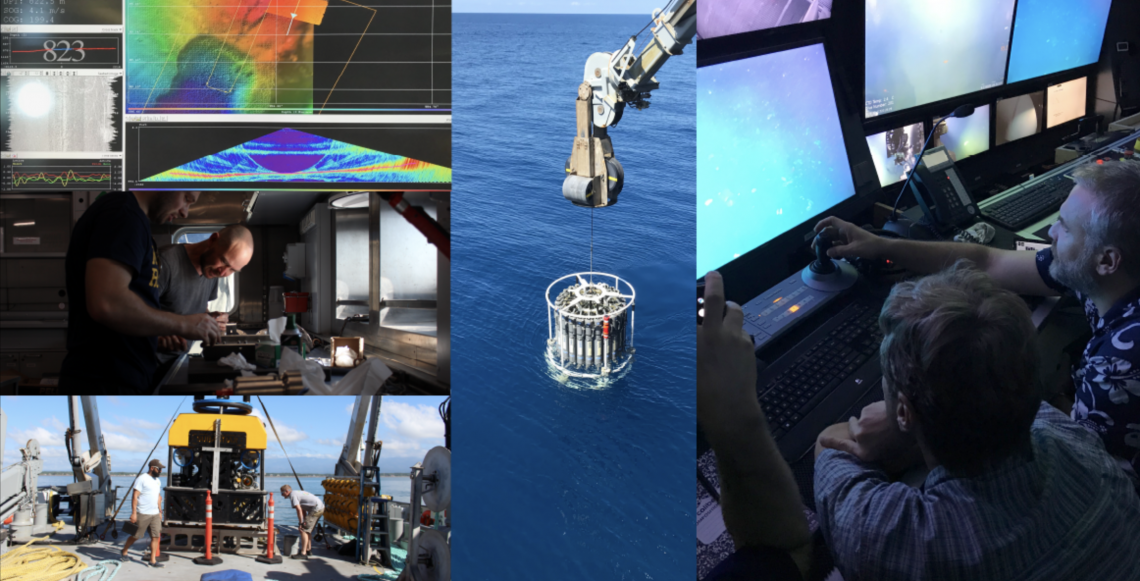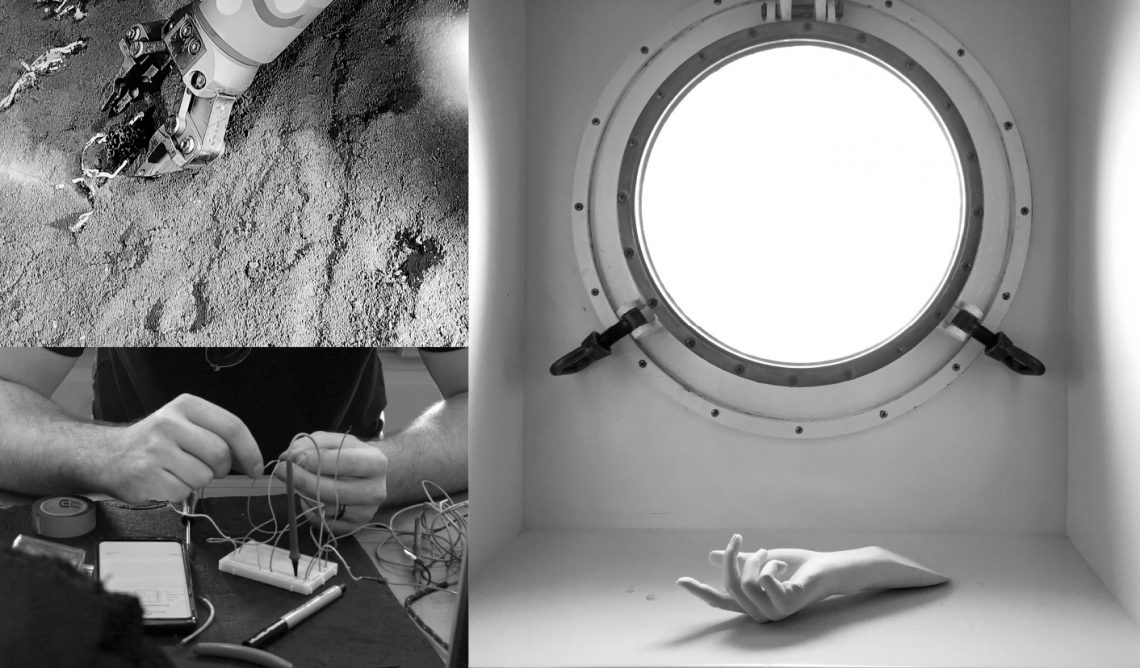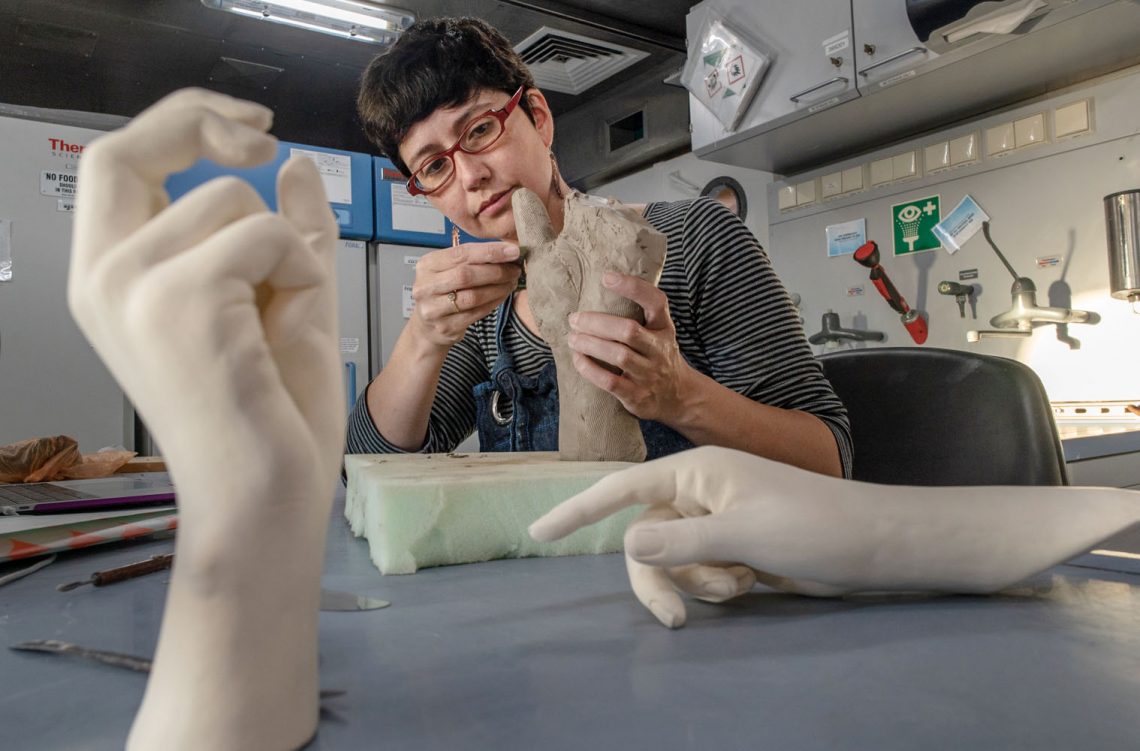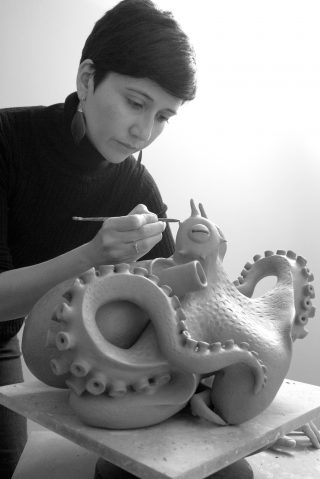Trying to work with clay during an oceanographic expedition focusing primary on autonomous robotic development might sound a little crazy. Ok, probably it is. However, my interest in interdisciplinary creation and exploration, plus serendipitous circumstances, put me here on the Falkor, sailing off the coast of Costa Rica. I am here with a group of scientists and engineers that are working to advance the development of autonomous robots used for exploration. Their efforts will help us understand and explore the deeper ecosystems of our planet, while their technology will also be used in outer space to explore the possible existence of life in other planets. Overall, thinking on the implications of what can be done with this research is mind blowing. Therefore, I guess that it is fair to ask why I would be working with clay in such a technological environment? Or maybe even before that, to ask why bring art to this expedition at all?
Let me answer the second question first. For me, art and science are just different ways in which we explore and try to make sense of the world. They are simply alternative (and in my opinion, complementary) methods in which we are trying to understand our place in the world and our relationship to it. Both art and science are creative process that can benefit from each other, as they push us to look at the same questions from different angles. They can force us to consider other possibilities which we may have not imagined if we had stayed in our own comfortable disciplines. For me, the beauty of interdisciplinary creation and collaboration are tied with how they expand our world view.

Exploring the world in the XXI Century
A few months ago, I read “The Invention of Nature,” a book by Andrea Wulf that narrates the life, voyages, and incredible artistic and scientific thinking of Alexander von Humboldt. What struck me the most about von Humboldt was the interconnectedness of his ideas: the global vision of the world and how he could move from local to global, from species’ ecology and distribution to physical features, from present time to geological scale. Undoubtedly exploration shaped the way he perceived the world and his capacity to incorporate constant change and connectedness in every idea. Exploration helped him develop an understanding of nature and its processes while also making him a visionary, in that he quickly became aware of the impact that human beings were having on this planet. Additionally, the profound influence that Johann Wolfgang von Goethe had on the young von Humboldt exposed him to beauty, poetry, and sensibility. This influence surfaced in his artistic abilities to visualize ideas in beautiful infographics while writing captivating narratives that inspired a new generation of thinkers: Charles Darwin, to John Muir, George Perkins Marsh, Simon Bolivar, and Ralph Waldo Emerson to name a few. Almost 200 years have passed and we are dealing with climate change, ocean acidification, and plastic islands. I am now on a voyage with a group of scientists who are mapping the seafloor and testing autonomous robots that record, test, measure, and make decisions on the depths of the ocean. These past few days I have had the opportunity to briefly experience how ocean exploration, collaboration, and creative endeavors are done in the XXI century, and I have had the opportunity to reflect on the place of humans in all this technological advancement and discovery.
Human Hands, Robot Hands
I am obsessed with hands. These extensions of our bodies have been shaped by evolutionary processes, allowing us to interact and shape our surroundings in novel ways. Frequently, throughout the day I feel that I think with my hands, I listen with my hands, and I understand with my hands; perhaps this is why clay sculpture became such a fundamental aspect of my peace of mind. Machines have been just extensions to our appendages, but now they are starting to make their own decisions. Surprisingly (or maybe not so surprisingly) this reminds me of octopuses. These amazingly intelligent creatures have a more diffused nervous system than we do, and their eight arms can make their own independent decisions within certain context. This independence gets overridden by the central nervous system in case of an emergency, which is why you may see the head leading when an octopus flees, swimming rapidly with the arms of dangling behind. Are we becoming octopus-like? Are we creating extensions of ourselves that have independent existence and that allow us to explore further our place in the world?

Modeling Technological Collaborations
Clay is a humble and noble material that has been so intertwined with human culture through the ages, that it, in my opinion, connects with people on a deeply fundamental level. So after a few days on the Falkor, I have become determined to use clay to sculpturally explore two aspects of this expedition and my experience of it, attempting to navigate through this tension of human and technology. First, I am interested in exploring the humanness of technological innovation, the making of people in connection to the robot’s autonomy. In other words, observing how the robots become an extension of the way in which we relate to the world, in a parallel way to how octopus’ arms are neurologically a bit independent of their central nervous system. Hands seems an obvious place to start, as our first tool in relating to the world. Second, I want to reflect on the co-creative aspect of this enterprise, where each of the scientists and crew are part of a greater whole in a specific setting and timeframe. In other words, contemplating how knowledge is being produced in this expedition as an emergent property of the ecosystem that has been built in it; as an interdisciplinary XXI century voyage of discovery.
In summary, my ideas for the sculpture that I will create in the Artist-at-Sea Program are being drawn from the intersection of interdisciplinary knowledge building, exploration in the XXI century, science, humans, technology, and clay. However, I must say that I always have in mind what the contemporary artist William Kendridge said in an interview: “My best work happens in-between the work that I thought I was doing.” So I guess that – similarly to science – even in the best planned expeditions you just never know… and what a place of wonder that creates!


